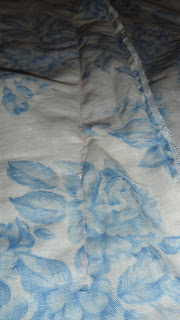Today I'd like to share the first dress I've ever made from a pattern! I have a huge stack of patterns that I've accumulated at random sales/Black Fridays, and I've finally got a round to working on them! I had to watch a couple video tutorials to help me read the pattern (believe me, it's like a whole other language).
Vintage, please!
Refashioning has been great, but I definitely feel more satisfied making something from scratch. Well, not exactly from scratch because I used a pattern, BUT it's still something from nothing, right??? Like I've mentioned earlier, I really like the 1940's, 50's style of madmen or pin up girls. The dresses that I see in boutiques or at online stores have been pretty pricey....so let's make magic! I've found a couple patterns made by Butterick, Vogue, and Collete Patterns that capture the silhouette of that era. Luckily for me, I snagged a couple Buttericks and Vogues on the cheap.
- I'm using a Vogue Vintage pattern (V1136). I first had to trace out the pattern pieces and cut them out. You can see Camilla, my little helper was completely worn out after a couple hours.
- I made a muslin of the dress and it took me about...15 hours to trace, cut, and assemble the dress. O.O wowza.
- Then I thought about how I would like to alter the pattern to make it more my style. The pattern placed a bunch of pleats by the butt area, which is not very flattering. I eventually redrafted the skirt back and narrowed the skirt (it originally came out a bit A-line).
- I bought the second fabric at Hancock's. They had a blowout sale that was 40% off with an additional 15% off coupon. I know that you should wash and dry the fabric before you sew because cotton is bound to shrink....but I couldn't wait :) The material has some stretch to it, but I wouldn't count on it to hold up to holding in my curves.
- I'm also psyched to say that my sewing machine is 100% awesome. With my prior Singer machine, it only came with the essential accessories (zipper foot and buttonhole guide), but my Brother machine came with ALL of the accessories, even the optional ones (narrow hem, blind hem, quilter, etc)! So I did a blind hem stitch on the bottom
- I didn't want to invest in an invisible zipper foot, so I did my best with the regular zipper foot
- Ok, now for the unveiling! I think it came out pretty well considering I still don't own an iron.
I just started messing around at the end :p I hope you guys enjoyed my post. I can't wait to start working on the next one :)
 |
| I wanted to add one picture that made me look domesticated. Didn't have a baby to swaddle, so I picked up my cat :) |
Bye bye!

























































